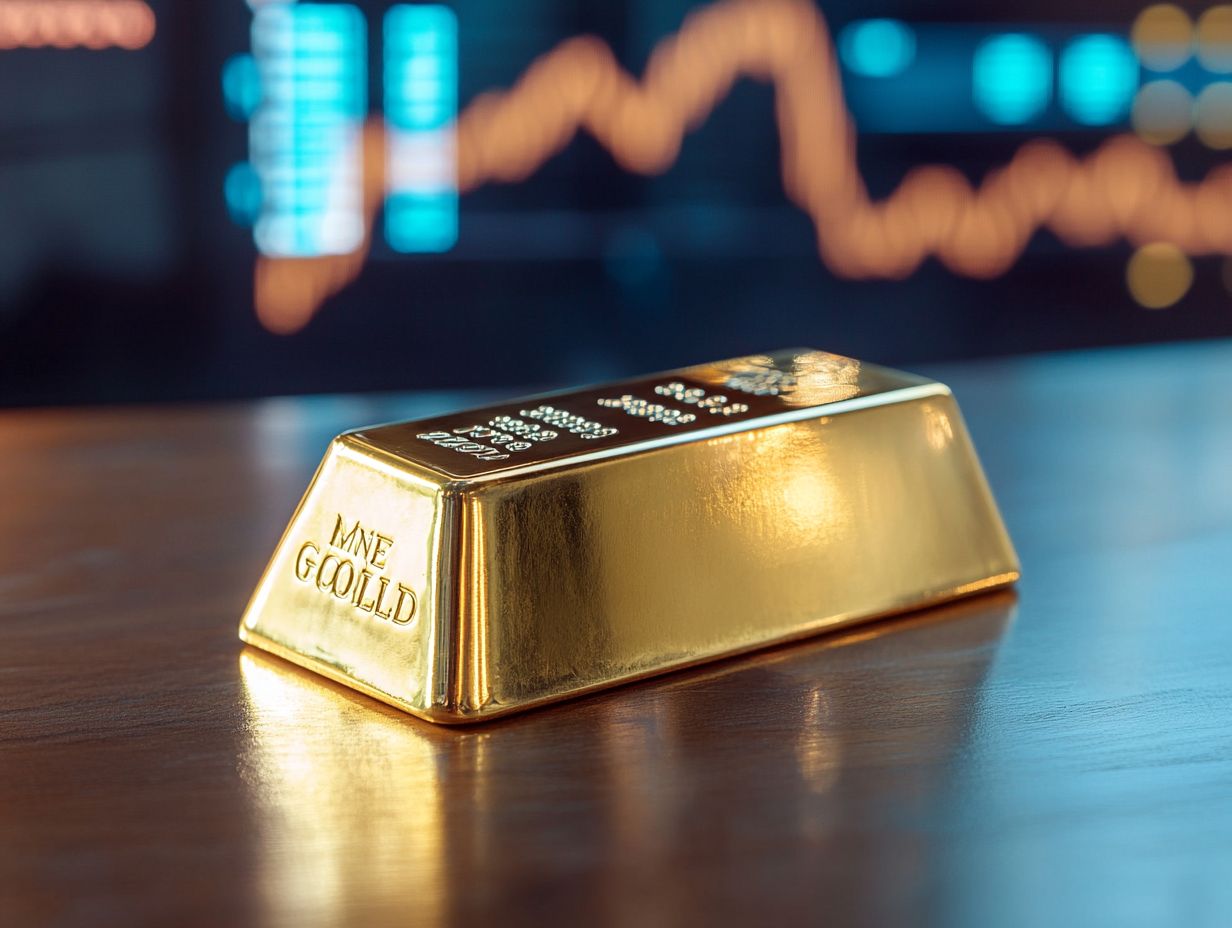Gold as a Safe Haven: Current Market Insights
Gold has long been celebrated as a safe haven asset. It serves as a refuge for investors seeking stability during turbulent times.
This article invites you to explore the concept of safe haven assets, placing particular emphasis on gold. You ll examine its historical performance alongside current market trends.
Delve into the myriad factors that influence gold prices and see how it stacks up against other safe havens.
The discussion will encompass the benefits of investing in gold, the potential risks involved, and practical tips for navigating this timeless investment.
Uncover why gold continues to shine brightly in the face of uncertain financial landscapes.
Contents
- Key Takeaways:
- Understanding Gold as a Safe Haven Asset
- Historical Performance of Gold as a Safe Haven
- Current Market Insights on Gold
- Benefits of Investing in Gold as a Safe Haven
- Considerations Before Investing in Gold
- Frequently Asked Questions
- What is gold considered as a safe haven in the current market?
- Why is gold often seen as a safe haven investment?
- How has the value of gold performed in the current market?
- Is investing in gold a good way to hedge against market volatility?
- Are there any risks associated with investing in gold as a safe haven?
- How can investors keep up with the latest market insights on gold as a safe haven?
Key Takeaways:

- Gold is considered a safe haven asset due to its historical performance during times of economic uncertainty and market downturns.
- Examining past market trends can provide insights into the potential future performance of gold as a safe haven asset.
- Factors such as global economic conditions and conflicts between countries can impact the price of gold and its position as a safe haven asset compared to other assets.
Understanding Gold as a Safe Haven Asset
Gold has long stood as the classic safe haven investment, particularly attracting investors who seek to preserve value during inflationary periods and economic turmoil. As a vital element of investment portfolios, its historical performance reveals a remarkable ability to protect purchasing power during market downturns and equity market fluctuations.
Central banks frequently hold gold as a strategic asset to cushion against downside risks. Its inherent scarcity enhances its appeal especially as the federal government grapples with intricate economic challenges that cultivate volatile market conditions.
Defining Safe Haven Assets
Safe haven assets are your go-to financial instruments that hold their value or even appreciate during times of economic instability. These assets are particularly enticing when inflation and market chaos reign.
They usually show a low correlation with the broader financial markets, serving as a protective buffer against volatility. Unlike stocks or real estate, which can swing wildly based on market sentiment or economic reports, safe haven assets provide a sense of stability and are frequently in demand during downturns.
Gold is one of the most popular safe haven assets, and it has proven its worth time and time again. To fully appreciate its significance, it’s important to grasp understanding gold market volatility. Other examples include U.S. Treasury bonds, renowned for their government backing and relative safety. In today’s ever-evolving financial landscape, digital currencies like Bitcoin are also emerging as potential safe havens, appealing to those who wish to hedge against economic challenges and inflation.
Historical Performance of Gold as a Safe Haven
The historical performance of gold as a safe haven asset is thoroughly documented, backed by empirical research that supports the safe-haven hypothesis. This research illustrates gold’s remarkable resilience during financial crises and times of inflation, making it a compelling option for those seeking security in turbulent economic climates.
Examining Past Market Trends
Examining past market trends reveals that gold has consistently performed exceptionally well during financial crises, serving as a reliable hedge against inflation and economic instability. This precious metal not only retains its value but often experiences a surge when equities falter.
Historical evidence from various economic downturns, such as the 2008 financial crisis, shows that gold prices climbed by nearly 25% while stock markets faced significant declines. During the uncertainties of the pandemic, the allure of gold drove its value beyond $2,000 an ounce, reaching an all-time high.
With inflation rates surpassing 5% in recent years, many investors are now turning to gold, and you should too, especially with rising inflation!
Current Market Insights on Gold

Current market insights reveal that the value of gold is significantly influenced by a range of factors, including inflation, geopolitical tensions, and supply caps. For you, this makes gold an essential focal point if you’re seeking stability in your investment strategy.
Factors Affecting Gold Prices
Several key factors influence gold prices, including inflation rates, interest rates, and overall economic instability. Each element plays a significant role in shaping gold’s perceived value amid shifting market conditions.
When inflation rises, investors may flock to gold to protect against the eroding purchasing power of fiat currencies, often resulting in price surges. Similarly, fluctuations in interest rates can dramatically sway gold valuations; historically, when rates drop, the opportunity cost of holding gold decreases, making it more appealing.
Economic instability, whether stemming from geopolitical tensions or financial crises, enhances gold’s allure as a safe haven. For more insights, check out Gold as a Safe Haven: Myth or Reality? Shifts in currency value introduce another layer of complexity; as currencies weaken, gold becomes pricier for foreign investors, typically driving up demand and prices.
Looking back at market reactions reveals a clear pattern. During uncertain times, such as the 2008 financial crisis, gold prices soared amid heightened fear and lowered interest rates.
Comparison with Other Safe Haven Assets
When you compare safe haven assets like Bitcoin and U.S. debt, gold often stands out due to its long-standing historical performance and qualities as a physical asset.
While digital currencies can be volatile, gold has maintained stability over centuries, preserving its value even during economic downturns and geopolitical turmoil. Bitcoin may be an intriguing alternative, but its drastic price swings could scare off risk-averse investors.
In contrast, U.S. debt may seem reliable during crises, yet it lacks the tangible value that gold provides. Commodities like silver and oil can support your portfolio, fluctuating with supply and demand, but they often overlook the historical strength of gold.
This nuanced view reveals a complex investment landscape where gold continues to be a cornerstone asset, worthy of your consideration.
Benefits of Investing in Gold as a Safe Haven
Investing in gold presents a wealth of benefits. It allows for diversification within your investment portfolio, helps protect against different risks, and offers protection from inflation.
Together, these factors contribute to more stable returns and reduce downside volatility, making gold a compelling addition to your financial strategy.
Diversification and Hedging Against Risk
Diversifying through gold investment can elevate your risk management strategies, empowering you to shield your portfolio from market downturns and uncertainty.
Incorporating gold into your asset mix serves as a reliable buffer during turbulent economic periods, often providing the stability that other investments may lack. For instance, during market volatility or inflation, gold as a hedge has historically preserved its value, attracting those who wish to safeguard their wealth.
When stock prices plummet due to geopolitical tensions or financial crises, gold can soften the blow, ensuring your portfolio doesn’t suffer excessive losses. With its low correlation to stocks and bonds, gold acts as an effective hedge against risks, enhancing the overall resilience of your investment portfolio.
Considerations Before Investing in Gold

Before you invest in gold, it s essential to weigh several important factors. Consider potential risks and downsides, examine current market conditions, and evaluate the asset’s liquidity, which refers to how easily you can buy or sell an asset.
These considerations empower you to make informed decisions that align with your financial goals.
Are you looking for stability in your investments? Investing in gold now could protect your wealth from future risks. Start your gold investment journey today!
Potential Risks and Downsides
Investing in gold offers advantages. However, be aware of potential risks, like market volatility and downturns that can affect value.
Recent market fluctuations have shown that gold, often seen as a safe haven during economic uncertainty, is not immune to significant price drops. For instance, in 2021, gold prices saw a notable decline from their mid-year peak, prompting some investors to reassess their strategies regarding physical gold as a safe haven asset.
Such downturns can impact your immediate financial returns and disrupt your long-term investment plans. This highlights the importance of thoroughly evaluating your risk tolerance.
Understanding how gold fits into your overall investment portfolio is crucial, as the asset’s performance can vary widely due to factors like inflation rates and political issues between countries.
Tips for Successful Gold Investing
Want to succeed in gold investing? Follow key principles that consider market conditions, the importance of research, and the role of gold in a diversified portfolio.
Understanding when to enter or exit the gold market can significantly influence your long-term returns. Stay updated on global economic indicators like inflation rates and geopolitical events as these factors often sway gold prices.
Keeping an eye on market sentiment and emerging trends will also provide you with valuable insights. Thorough research is essential; utilizing analytical tools and seeking expert advice can significantly enhance your decision-making process.
By strategically incorporating gold as a hedge against volatility, you can fortify your investment mix and potentially protect your wealth against economic downturns.
Frequently Asked Questions
What is gold considered as a safe haven in the current market?
Gold is considered a safe haven in the current market because it has historically maintained its value during times of economic and political uncertainty.
Why is gold often seen as a safe haven investment?

Gold is often seen as a safe haven investment because it is a tangible asset that is not affected by fluctuations in the stock market or currency values.
How has the value of gold performed in the current market?
The value of gold has performed well in the current market, with prices increasing due to global economic concerns and low interest rates.
Is investing in gold a good way to hedge against market volatility?
Yes, investing in gold can be a good way to hedge against market volatility as it is often seen as a safe haven asset that provides stability in times of market turmoil.
Are there any risks associated with investing in gold as a safe haven?
While gold is generally seen as a safe haven, there are still risks associated with investing in it. Its value can fluctuate, and it may not always provide a high return on investment.
How can investors keep up with the latest market insights on gold as a safe haven?
Investors can keep up with the latest market insights on gold as a safe haven by regularly monitoring financial news and staying informed about global economic and political events that may impact its value.













